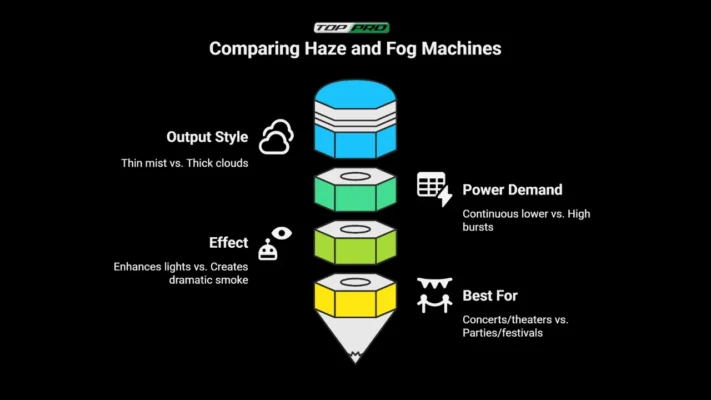Why Do Fog or Haze Machines Use So Much Power?

At first glance, fog or haze machines might seem like simple boxes that pump out smoke. But here’s the truth: they’re built to consume serious amounts of power — and that’s exactly what makes their effects possible.
In 2025, power management for fog and haze machines is critical. One miscalculation can trip a circuit, cut off sound and lighting, and ruin the entire event. This guide explains why these machines demand so much power, how they work, and how to run them safely.
What You’ll Learn
By the end of this guide, you’ll know how to:
Understand why heating elements are power-hungry by design.
Learn how haze machines and fog machines work differently.
Compare haze vs. fog effects and their purpose.
Match machine wattage to venue electrical capacity.
Avoid common mistakes that trip circuits and damage equipment.
How Haze Machines Work
Haze machines heat a specially formulated haze fluid until it becomes a fine mist. Instead of big, rolling clouds, they create a thin atmospheric layer that makes beams of light visible without overwhelming the room.
The heating element keeps the fluid at a stable temperature so particles remain consistent in size. This constant low-output cycle means haze machines often run continuously during events.
How Fog Machines Work
Fog machines, on the other hand, vaporize fog fluid into dense clouds that expand rapidly. Unlike hazers, they produce bursts of thick smoke that fill a space quickly.
Because of the high heat needed to vaporize large amounts of fluid in short bursts, foggers demand much higher wattage than hazers. A typical fogger can require 1000–3000W, depending on size.
Haze Machine vs. Fog Machine: How Do They Compare?
Feature | Haze Machine | Fog Machine |
| Output Style | Thin mist, atmospheric layer | Thick clouds, dramatic bursts |
| Power Demand | Continuous but lower | High bursts, 1000–3000W |
| Effect | Enhances beams/lights subtly | Creates visible, dramatic smoke |
| Best For | Concerts, theaters, light shows | Parties, weddings, festivals |
Haze Machines – Effect and Purpose
Haze is about subtlety. It makes laser beams, LED washes, and moving lights visible without distracting from the performance. DJs, theaters, and TV studios often rely on haze to create depth and atmosphere.
Smoke (Fog) Machines – Effect and Purpose
Smoke (fog) machines deliver impact. They create dramatic bursts that fill a dance floor, roll across a wedding stage, or pour into outdoor spaces at festivals. Their purpose is visual intensity, and that intensity comes at a cost: high power consumption.
Why Do They Consume So Much Power?
Both haze and fog machines rely on heating elements that reach 200–300°C to vaporize fluid. The denser the smoke or haze, the more power required.
- Pre-heating cycles: Many units need 5–10 minutes before they’re ready.
- Continuous heating: Large machines keep elements hot to ensure instant vaporization.
- Venue size: The bigger the room, the more powerful the machine must be.
Power-Proofing Your Fog/Haze Setup
- Confirm wattage vs. venue circuit capacity.
- Use the manufacturer’s recommended fluid.
- Pre-heat fully before showtime.
- Test the machine under half-load conditions.
- Use event-rated power cables and breakers.
- Have a backup haze/fog unit on standby.
Conclusion
Fog and haze machines consume a lot of power because heat is the engine behind every effect. With the right planning, you can run them safely, match them to your venue, and keep your show running smoothly.
For professional-grade foggers and hazers that fit your event, visit TopProSound.com—your trusted source for sound equipment and Professional Stage Lighting in Dubai.
FAQs
Is smoke from smoke machines harmful?
Most fog and haze fluids are water-based and safe when used properly. Oil-based fluids can cause irritation if ventilation is poor. Always use manufacturer-approved fluids and ensure proper airflow.
Can a fog machine trigger a smoke alarm?
Yes. Dense fog can set off standard smoke detectors. Venues in Dubai and Abu Dhabi often require coordination with management to adjust alarms during shows.
How much power does a fog machine use?
Small machines use 400–700W, while professional foggers may demand 2000–3000W. Always confirm your venue’s electrical capacity before setup.
What’s the difference between haze and fog?
Haze is thin and continuous, making light beams visible without overwhelming a room. Fog is dense and dramatic, creating rolling clouds for impact. Each has a unique purpose in events.
How long can fog or haze last in the air?
Fog dissipates quickly, often within minutes, depending on ventilation. Haze lingers much longer, sometimes over an hour, making it ideal for consistent lighting effects.
Can I use any fluid in my fog or haze machine?
No. Each machine requires specific fluid types. Using the wrong fluid can damage the heating element or create unsafe residues. Always check the manufacturer’s recommendation.








